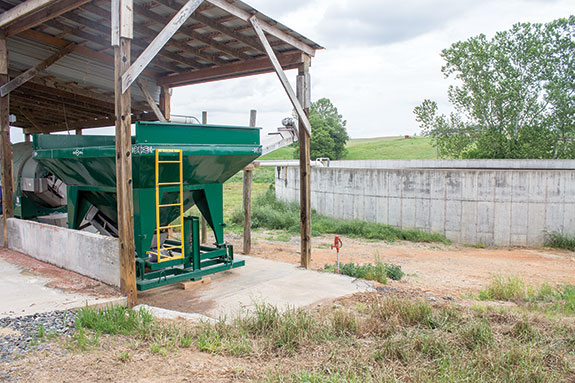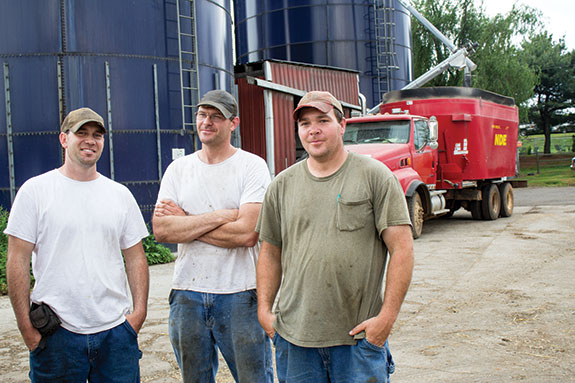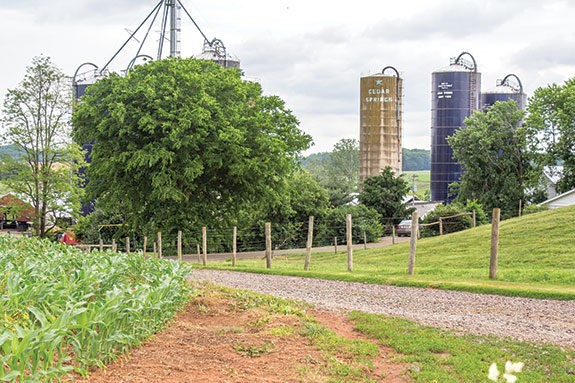At Cedar Springs Dairy in Rochelle, Virginia, that’s not just a maxim; listening is a proven key to the success of brothers John and Earl Lamb and their sons.
Peter Maybach, who helps with the soil testing on the farm, says, “A long time ago, the very first time I pulled on this farm when I was just young, Earl pulled me over and said, ‘Listen, my job is to leave this farm better than when I got it.’
He said, ‘I promise to do anything you say, but it’s gotta be better than when I’m not here.’”
And Earl and John did listen. In 1972, they had some bottomland in Charlottesville that didn’t produce well. They took a soil sample and found the pH was 4.6, so they started using recommendations from Maybach’s agricultural consulting company and have done so since, employing no-till and cover crop techniques, using liquid manure applications and reducing compaction.

Earl says, “The point I am most proud of, being in agriculture, is the fact that when we started our organic matter was somewhere around 1.5 to 2.
We’re up now on most fields 4.5 to 5, and I’m proud of that. It doesn’t matter what kind of fertility you have; without organic matter, you can’t grow crops.”
Cedar Springs Dairy is more than just rolling fields. It’s rolling and rolling and rolling – so much so that you can hardly see the next field.
This adds a tremendous logistical problem to an already challenging red clay soil.
In fact, if enough heat was added to the red clay, it could literally make a brick. The organic matter improvement that Lamb referenced wasn’t a miracle – it was the result of listening and being willing to make changes.
What changes did they make? Well, it didn’t happen overnight. This year, as in past years, the dairy planted 240 acres of cover crop using rye or barley, Australian peas, vetch and tillage radishes.
One of the cover crops they’ve been most successful with is tillage radishes, attributing 3 to 4 tons more corn yield per acre to that cover crop alone. Lamb states that the radishes loosen the soil, and they try to plant it as soon as the silage comes off or by September 15 at the latest.
This gives the crop time to establish before a cold frost hits. If the winter temperatures are hard, the crop will kill down. If the winter is mild, they have to use a burndown application in the spring. Either way, the radish crops leave large aeration holes in the soil and improve organic matter.
Another major factor in soil improvement on the farm came in 2002, when Cedar Springs Dairy invested in a system to separate manure solids from the dairy waste.
Today, manure solids are trucked to farms up to six miles away, while the liquids are pumped onto the fields. The system pumps about 500 gallons per minute.
The largest single day of pumping placed 300,000 gallons onto the fields, taking 50 gallons of fuel to accomplish it. That 300,000 sounds like a lot, and may scare some folks, “But remember,” Maybach says, “it’s 90 percent water.”
Lamb notes, “We didn’t know if the system would work, but we knew something had to change. It was a gamble but, boy, it has paid off. I would advise anybody who has enough water to liquidate the manure and pump it. Just not having to work the soil – it’s worth a lot.”
One of the most proactive things Lambs have done was to anticipate the Chesapeake Bay watershed problems 10 years in advance, recognizing the need to reduce phosphorous loading close to the barn. That’s when they started separating manure solids and trucking them down the road to other farms.
As an example, Lamb relates that just two weeks prior, the farm received 5 inches of rain. Twenty years ago, they would have had to work the soil after a hard rain on a field spread with solid manure and then would have lost some of that manure and soil in the runoff. He states that with their system of pumping liquid manure, even after a heavy rain, the soil will hold it.
With these changes, the Lambs haven’t used a subsoil treatment for about nine years and haven’t tilled any soil at all for the past eight years, even when seeding alfalfa. Lamb notes there isn’t any more rock picking to do either, and that’s not coincidental.
Maybach says, “With what the Lambs have done, this soil now begs to have a seed put in it. Didn’t used to be that way.”
John and Earl’s mother started the dairy milking 75 cows. The dairy has grown steadily until today there are 550 Holstein cows (475 milking, averaging 72 pounds of milk rolling herd average) and 150 Angus beef cows on 4,000 acres (of which 1,500 acres are rented).
They plant 1,150 acres of corn (500 acres for chopping), 725 acres soybeans, 200 acres rye (chopped for haylage), 200 acres alfalfa (cut five times a year), 250 acres grass hay for young stock and beef cows, and 120 acres of barley.
They market 250 Holstein steers every year at 1,000 pounds and market the beef calves at 800 to 900 pounds. Forage for these herds all comes from 700 acres of farmland, which usually produces some feed surplus as well.
A herd this size and the cropland to back it takes quite a crew to keep it running and, by their own admissions, John and Earl aren’t young bucks anymore.

Fortunately, their sons – John II, Josh and Lewis – have joined them in the operation and are raising their families on the farm.
Earl admits, “One of the hardest challenges for me as the young men came along was to step back and watch them take over, watch them make mistakes and yet try not to get too angry.”
With time, patience and fortitude, Lambs have successfully incorporated family members into the business, adding talent, value and depth to the enterprise.
Each member of the team has specific areas of expertise and responsibility.
Each is willing to listen to the others, as when Josh, for instance, convinced the team to use a pasteurizer on the milk fed to the calves. Josh says, “Calves are getting proteins that you can’t buy in a bag, and the calves are doing a lot better. It paid for itself pretty quick.”
While the process of incorporating their sons into the business included some give-and-take, with pride Earl notes, “As far as agriculture, I would put ’em up against most anybody, and I’m proud of ’em. John and I have always known that the whole thing we farm for is the future, the next generation.”
Yet, in virtually the next breath, Earl humbly concedes, “We feel very blessed that God has blessed us with this farm in being able to move forward as much as we have because we already know that we’re nothing. I can put the corn in the ground, and I can put the beans in the ground, but I can’t make it grow, and that’s come from the good Lord. And we just thank Him every day.” FG
PHOTOS
TOP: Cedar Springs Dairy
MIDDLE: Now that the farm separates manure solids and pumps the liquid manure onto fields, combined with cover crop plantings, tillage operations are reduced and soil composition has improved significantly.,
BOTTOM: Josh, John II and Lewis Lamb bring their third-generation ideas and collaborative efforts to the Cedar Springs Dairy team. Photos by Lynn Jaynes.












